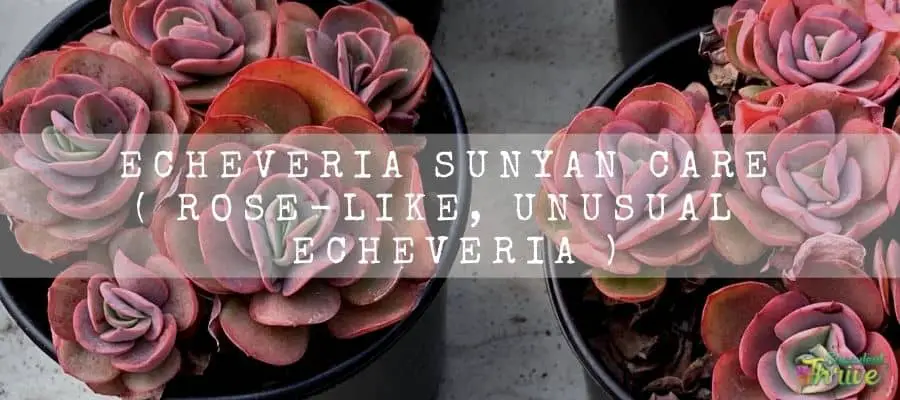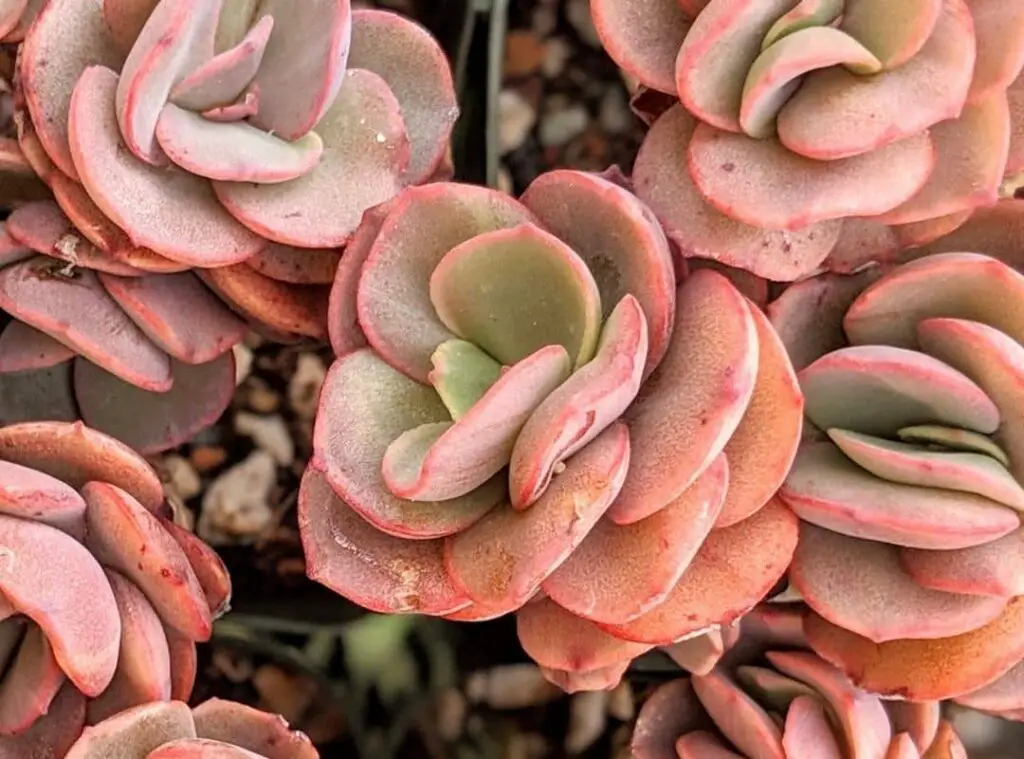Echeveria sunyan is considered as a top pick succulent. They would be such great additions to any kind of pot.
They are famous for their magnificent bright and beautiful rosettes. Additionally, they produce flowers and that will be an added advantage of having these precious plants.
If you wish to add some contrast to your succulent’s garden, Echeveria sunyan would be a perfect match.

Echeveria sunyan requires an easy-care treatment from you. They would be a perfect set of plants which could thrive well in balconies as well as in your gardens.
Echeverias are hardy, versatile plants which anybody would want to have.
So, from this article, I am going to cover how you should look after them, the methods of propagating, the common bugs and diseases they may come across.
It would be worth reading this article if you wish to start growing the Echeveria sunyan plants.
How do I identify Echeveria sunyan?
You can identify the Echeveria sunyan from their foliage and color.
They generally look green. Once these plants go through stress, chances are that you could spot them turning pink.
Further they would be about 6-8 cm in height. Echeveria sunyaney produce rosettes as they grow. Additionally, they produce flowers during spring and Autumn. They would be pink in color.
Size of the plant
Echeveria sunyan would reach a maximum height of 6-8 cm when they grow to the fullest.
Growth rate
Echeveria sunyan grows at a moderate rate.
One look care guide
| Botanical Name | Echeveria sunyan |
| Common Name | Echeveria sunyan |
| Plant Type | Succulent |
| Mature Size | height of 6-8 cm |
| Sun Exposure | Full sunlight to partial shade |
| Soil Type | Well-draining gritty |
| Soil pH | Neutral |
| Bloom Time | Spring and Autumn. |
| Flower Color | Pink |
| Hardiness Zones | USDA hardiness zones 9-12. |
| Toxicity | Non Toxic |
| Average price | 12 USD |
How do you take care of Echeveria sunyan?
Light Requirement
You could find the Echeveria sunyan growing in warmer climates when they grow in the wild along with a lot of sunlight.
Hence when you grow them as houseplants, you need to provide the same conditions for them. Having said that,do not expose them to drastic changes in sunlight also at once since it could traumatize the plants.
What I suggest you do is slowly acclimate them to full sunlight. Ideally expose them for a few hours at first and then slowly increase the exposure for sunlight in a gradual manner.
Refrain from exposing them under intense sunlight particularly during afternoon hours as it would be unhealthy for the plants.
Sunburn could be so dangerous as it is very unlikely that you can get rid of those sunburns in the plants. Best thing to do in such a situation would be to use the healthy plant parts and propagate them.
When you grow them as indoor plants, select a place like a windowsill since then they can gain bright sunlight particularly during winter.
Further if you think they still lack proper sunlight levels, you should consider placing artificial lights such as grow lights.
Temperature and humidity
Echeveria sunyan is tolerant to numerous temperatures. However, they would happily grow in warmer temperatures.
During winter, the best thing would be to shift the plants indoors as they cannot withstand colder temperatures and frost.
During summer, they can tolerate hot and warmer temperatures. Having said that, it is best to provide some shade during intense summer conditions.
Is it cold hardy?
USDA Hardiness Zone
Echeverias are hardy in USDA hardiness zones 9-12.
Watering Requirement
Watering the Echeveria sunyan well has a direct impact on looking after these plants well. Ideally, they need to have a lot of water during summer.
On the other hand, they can withstand little water in winter when there are cooler weather conditions.
Best is to use rainwater when watering these plants. Besides you may use tampered water also for them. If you supply excess water for them, it will make the plants more vulnerable for root rot etc.
Do not leave them exposed for moisture for too long or leave them in a saucer of water as it would be unhealthy for the plants.
Soil Requirement Type / pH
A well-draining soil mix is a must to grow the Echeveria sunyan plants. If you leave them for excess moisture as aforesaid, it would be the biggest mistake you do for the plants.
Literally it would lead to root rot. Best would be to use a peat based commercial mix to have a fast draining of the soil mix.
You may also use a sterile substrate. You may add elements such as grit or other small gravel , pumice to better the draining of the potting medium.
Refrain from growing them in alkaline soil especially when you do not water them with alkaline water. Do not provide fine sand, it could clog up the pores in the soil.
Pot size Potting and Repotting.
Echeveria sunyan would perform well if you provide them with terracotta clay pots. Alternatively, you can grow them in other potter containers also.
The unglazed interior and the porous wall would be beneficial for the Echeveria sunyan’ s optimal growth. Literally the excess moisture will evaporate faster, and it will make the soil dry.
In terms of repotting the Echeveria sunyan, you do not have to repot them on a frequent basis as they are not fast growers.

Where to Plant
Select a spot where they can gain sufficient sunlight levels. That would be the prime requirement that you need to think of when thinking of a proper location to grow them.
Fertilizer and time of year
A controlled release fertilizer would work well with the Echeveria sunyan plants. Further you can apply those fertilizers during the start of their active growing season.
Further you may use a weak liquid solution and you could apply it once every week when they actively grow.
Moreover, you may also use a 20-20-20 balanced fertilizer which is at a quarter strength on the plants which are older.
Furthermore, You can add a fertilizer which has a low nitrogen component on the immature plants.
Generally , Echeveria sunyan pants do not thrive a lot on fertilizers. However , if you spot your plants are pale and lethargic , you can proceed with the aforesaid fertilizers.
Further you can also add worm castings and sprinkle them on the top layer of the soil and that will also provide them the nutrients they want.
The specialty of these is that they will slowly release the nutrients. It will never result in the feed burns in the plants.
Flower
Echeveria sunyan produces flowers in pink. Further their flowering season would be in the spring and autumn.
Dormancy
Toxicity
Echeveria sunyan are not toxic plants.
Common bugs and illnesses
Echeveria sunyan usually are resistant to diseases and to pests’ attacks given that you look after them well.
They want minimal supervision from you as explained in the beginning of the article. However, if there are any issues, it could mainly be due to the faults you do in watering.
Further drastic fluctuations in temperatures may also result in these issues. If you spot your plants becoming pale and look etiolated, it could be due to lack of sunlight.
Additionally , pests such as mealybugs may also attack these plants. To treat them, you need to spray the plants with an insecticide.
Further they may suffer from root rots also if you end up over watering the plants. Hence when you water them, ensure that you let their soil wither between watering sessions.
Limit watering them during cooler months such as in winter and in autumn.
Special Care tips
Echeveria sunyan requires easy maintenance from you. However, make sure that you refrain from exposing them for direct sunlight at once.
Further avoid splashing water on the Echeveria sunyan leaves. so that it will avoid any rot which could take place.
Additionally, you need to use an inorganic well-draining gritty soil mix as explained in the above
Benefits
Echeveria sunyan plants are useful as container plants as well as patio plants. Besides, you can use them as fine outdoor plants also.
How to propagate Echeveria sunyan
You can propagate the Echeveria sunyan by using their seeds, leaf cuttings etc.
Out of all these, using stem cuttings and leaf cuttings would be easier rather than doing it with the seeds. Further you can make new plants from Echeveria sunyan offsets as well.
However, to propagate them from leaf cuttings, you need to first clip the number of leaves you want depending on the number of plants you want to have.
I recommend you use mature leaves as then that will help them to form leaves. Next arrange a soil mix which is well draining.
You may either go ahead with succulent soil mix or make a mix on your own by mixing ordinary potting mix and sand in balanced amounts.
Next, you need to place the substrate in a pan and lay them down in the soil layer. Skip watering them. Ideally you need to place them in a warmer airy place where they can gain indirect sunlight.
Next you can start misting them on and off. The potting medium needs to be damp. You will see how they start to send out roots and how they form leaves.
When they are well established, you can transplant them in individual pots.
Conclusion
To wind up, Echeveria sunyan are such a versatile set of plants which will flourish if you look after them well. It would be pleasing to watch them in full blossom also.
If you ensure that you look after these plants well, they will perform well and keep gracing the entire space wherever you plant them.
Read Next : Echeveria Trumpet Pinky | Amazing Trumpet Shape Succulent | How To Care “Echeveria Petra’s Perle”? (Everything You Need Is Here) Echeveria Rainbow | This Multicolor Succulent Will Blow Your Mind | Echeveria Lutea | An Unusual And Beautiful Succulent | Echeveria Chihuahuaensis Variegated | Learn About These Small Beauties
